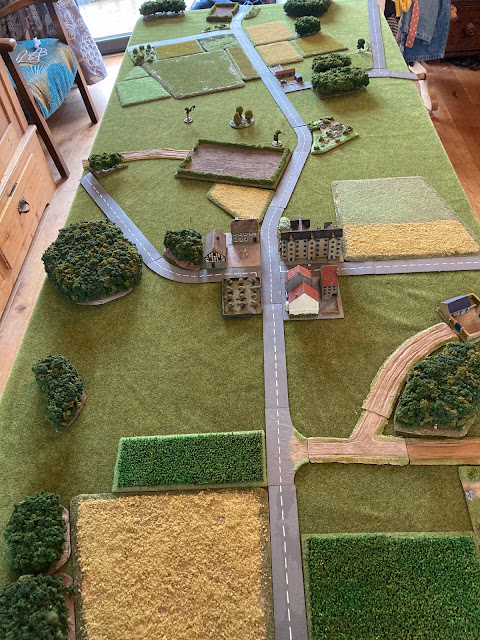Inspired by Al Sheward's brilliant Oosterbeek terrain at Ebor Lard, I've been thinking about how I might apply some of the techniques in 6mm scale.
Al's terrain consisted of modules (e.g. a building surrounded by gardens and outhouses on a single base) that could be placed side-by-side to fill the area of the table. There are advantages to this including storage and flexibility. A terrain module that fits exactly into the space at the corner of Utrechteseweg and Stationsweg will also work perfectly well in some alternative fictional setting.
One way to have modules that fit together is to give them all right-angle corners. This is something that Richard Phillips has done to great effect in his terrain for the Cold War Commanders games at various shows.
I've done something vaguely similar with some fields I've produced recently.
Because I want to use them for Germany and Czechoslovakia, I've eschewed the use of hedges, the field boards just have chamfered edges covered in a contrast colour of flock/static grass mix.
I then wondered if there was some mileage in producing small modules specifically designed to slot together but more irregular in shape. Using a few offcuts of PVC board I've knocked up these over the last few days.
The oddly-shaped road junction was a piece I'd made from a left-over scrap of cheap vinyl floor tile; my go-to material for 6mm tarmac roads. I cut a piece of PVC board to slot up against its wavy edge. I chamfered all the edges of the small field, coated it with quick-drying Polyfilla, and stuck in some bits of cat litter along the roadside edge to represent stones moved from the field by the farmer.
I then realised that a straight road piece attached to the junction would create an inconveniently shaped triangular space so I quickly made a small grassy extension to the field. With a bit of clump foliage to hide the join, I think the effect's OK. I'll do some more of this sort of thing.
The use of clump foliage to hide joins is important, I think. In the pics below are a couple of areas of broken round I've made from recycled bases of old forest pieces.
I've now got plenty of terrain for at least one Prague Summer 1948 table. Just another five to do!






Excellent progress Mr C. Working on some more irregular shapes as well but it's difficult making them completely modular. I'm thinking of have the same radius road bends for all roads might work?
ReplyDeleteNice work there and very effective. I've started basing a lot of my BUA bases on 3" squares, so that they all fit together quite nicely. Also my fields are often in multiples of 3, which helps with things fitting together nicely. Where there are gaps, then the good old lichen comes in handy to covers them.
ReplyDeleteCheers Richard. I like to make irregular bits of terrain with whatever bits of board are lying around. You're far more more rationalist about these things than me!
ReplyDeleteThanks Steve!
ReplyDeleteThere's a lot to be said for standardised sizes but it's not for me.
That's a great idea and I have tried something similar. I'm not a big fan of a square grid for towns (which is something your saw a lot of with Spearhead) and I have come up with some irregular shapes for towns which are pretty flexible. I blogged about it here https://6mmwargaming.home.blog/2022/06/22/town-planning/ but I'm yet to finish them!
ReplyDeleteThanks Kieran; some good ideas there!
ReplyDeleteLove your site by the way. I like the idea of 6mm scale SOBH; great for portable gaming!
Nice work there, I'm glad I read through all the comments as I was about to share a link with Kierans site, which I have found really inspiring for my own terrain making!
ReplyDeleteThanks Neil!
ReplyDelete